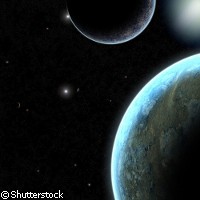Ice structures show mysteries of universe
Very cold ice films on interstellar dust particles are found in the universe but detailed information about the films' structure has not been readily available, scientists say. Now, state-of-the-art technology is giving researchers a chance to create ice films in cold conditions similar to those found in outer space, and to examine their molecular organisation. This will give them clues to help them understand various intriguing questions including abiogenesis, the origins of life on Earth. An exploratory workshop held by the European Science Foundation (ESF) focused on frontier research currently being undertaken on ice structures. For most people, ice is synonymous with the frozen water we crave in our summer drinks. But there is a lot more to ice than meets the eye, as was made evident in the workshop recently held in Granada, Spain, the main aim of which was to generate ideas for a future European network around this subject. The event was co-chaired Dr Julyan Cartwright, a specialist in ice structures at the Andalusian Institute for Earth Sciences (IACT) of the Spanish Research Council (CSIC) and the University of Granada in Spain and C. Ignacio Sainz-Diaz, also of the IACT. According to Dr Cartwright, the study of these ice structures could lead to revolutionary breakthroughs in other fields as well as having many industrial applications. Some of the amazing properties of ice have long been known. For example, it is the only non-metallic substance to expand when it freezes. The workshop however included many experimental and theoretical points of view, on not only water ice, but also other ice and solids condensed from different types of gases that exist in the extreme conditions of space. It also covered topics such as polymorphism and polyamorphism of ice, nucleation, morphology, reactivity and spectroscopy. The main focus of the workshop was on ice in space, however. This ice exists on small grains of dust, as well as on asteroids, comets, cold moons or planets, and occasionally planets such as Earth, capable of supporting life. Perhaps the most famous of all ice in space are the rings around Saturn. These rings are made from ice particles along with other debris and dust. In the low temperatures of space, ice is formed between 3 and 90 degrees above absolute zero, where absolute zero is at minus 273.15 degrees Celsius. At these low temperatures, ice can create different structures at the mesoscale (one size larger than the microscale) than at terrestrial conditions. In some cases these can be amorphous in form, like a glass with the molecules in effect frozen in space, rather than like a crystal. What many researchers have seen is that under certain conditions, ice can create biomimetic forms. In other words structures that appear life-like such as palm leaves or worms, or even at a smaller scale, like bacteria. For this reason, Dr Cartwright was quick to point out that researchers should not assume that life-like forms in objects obtained from space, like Mars rock, is evidence that life actually existed there. 'If one goes to another planet and sees small wormlike or palm like structures, one should not immediately call a press conference announcing alien life has been found,' said Dr Cartwright. However, this ability to mimic lifelike structures suggests that nature may have copied physics. 'It is clear that biology does use physics. Indeed, how could it not do? So we shouldn't be surprised to see that sometimes biological structures clearly make use of simple physical principles. Then, going back in time, it seems reasonable to posit that when life first emerged, it would have been using as a container something much simpler than today's cell membrane, probably some sort of simple vesicle of the sort found in soap bubbles,' said Dr Cartwright. 'This sort of vesicle can be found in abiotic systems today, both in hot conditions, in the chemistry associated with "black smokers" on the sea floor, which is currently favoured as a possible origin of life, but also in the chemistry of sea ice.' This notion will be further explored in projects that have spun off from the ESF workshop.
Countries
Spain



